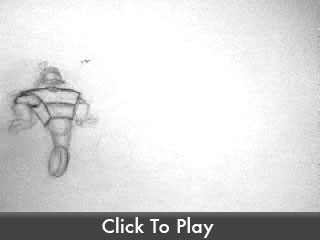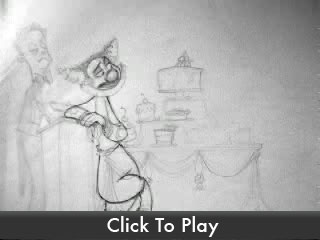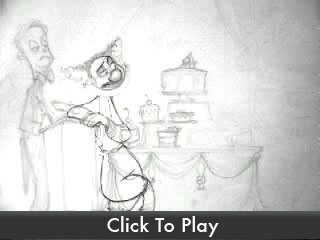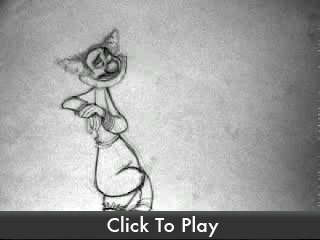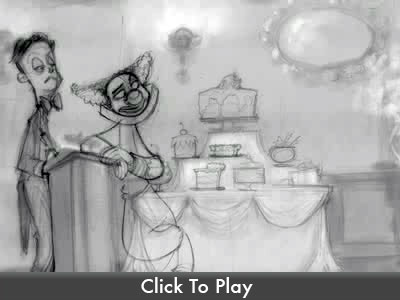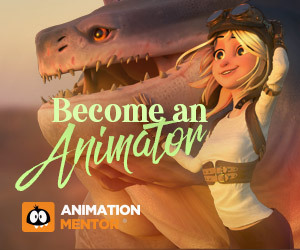BJ Crawford
Interview conducted by Eric Scheur
Before beginning this interview, I should issue a warning to all sufferers of Coulrophobia: The following interview contains discussion and images of crazy-haired, face-painted entertainers. Yes, I am talking about Clowns. If you want to turn back now, please know that you have our sympathy and understanding. For those wishing to continue, I salute your brave hearts. I also think that you'll find some very interesting insights from June's competition winner, BJ Crawford, about what kind of preparation it takes to rise to the top of 137 animators.
Ready? Brace yourselves; here we go!
- Eric
What drove you to get into animation?
My interest in animation developed very early on. I was always more fascinated in moving cartoons than in graphic novels, comic books, or comic strips. I would pause my VHS tapes and draw the characters and scenes I liked the best. Then I would start matching those characters to the names of animators who worked on them.
Where did you study?
I went to Sheridan College and graduated in 2000. I was so lucky to have graduated with the Class of 2000. There was an amazing pool of talent that came out of that year. Everyone was extremely gifted and very hard working.
Care to share any fun memories of those school days?
There were many late nights there. The lines outside the camera room to sign up for an hour's worth of time on the Bolex would start at 6pm the night before. Ugh. And you couldn't be at your desk working, you had to be in line, sitting on a cold tile floor, like you were waiting to by a new version of the iPhone or something.
I do recall many crazy late nights. I mean people just get plain 'ol silly at 3 in the morning. That was my first introduction to the music of Stephen Sondheim, and if you know who he is, you know that you really have to pay attention to the lyrics of his songs to get anything out of them. So between concentrating on animation and complicated song lyrics all at 3 in the morning, well, you can imagine I wasn't very productive in school. Nowadays I wouldn't even think of creating a bunch of distractions when trying to plan out important animation.
Looking through the art on your blog, it looks as though you're comfortable with many different styles of illustration and painting. Do you enjoy experimenting?
I love animation and illustration, but I don't think I would be too good at marketing a style all my own. I'd much perfer to try and animate in the style of someone else and let my own identifiable gestures show through in what I've done.
The love of experimenting comes from an exposure to the all of the artists working at the NFB. I also had the opportunity to work at Reelworks Animation in Minneapolis during my summer months off. Both of these places really do a great job of playing with the idea of "moving art." That has always seemed to me like an area where 2D animation has very happy home.
Scanning some of your older work, I love, love, love the fact that you have some Darkwing Duck sketches up there! What attracted you to the Terror that Flaps in the Night?
Yes! Darkwing Duck! Those sketches were right after I saw the movie The Prestige, and for some reason I had it in my head that I would combine that with the Darking Duck cartoon. As I remember, the Hugh Jackman character and the Darkwing Duck character had a bit of over lap in their personalities...
I was much more of a fan of Duck Tales. I would draw Gizmo Duck ALL THE TIME, and that was before my family had a VCR, so all I could do to learn how to draw him was to watch the show everyday, in hope that he was in the episode. Eight years ago I tried roughing out a scene of Gizmo Duck on a ball, which I though was kinda fun, concidering that he has a wheel instead of two feet.
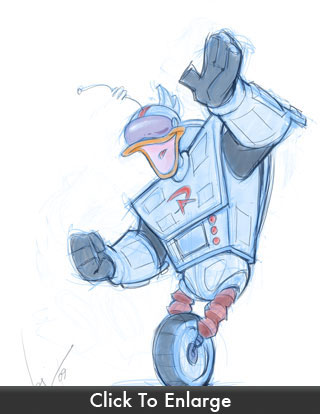
What are your goals as an animator?
Small bits of my animation appear in tons of commercials that use 2D animation for their campaigns. I've worked with several extremely talented directors in the commercial world. All of them have taught me different things about animation.
With the help of Chewbone Animation in Chicago, I finished my short film (A Time for All Seasonings) from college, and screened it at a few film festivals. In 2007 I helped bring together 9 animated short films produced by Chicago animators and screened them at the Portage Theater, the same place they filmed parts of the Public Enemies movie. About 500 folks from the animation community in Chicago showed up and it was one of the highlights of living in that city.
As far as the future goes, I guess only time will tell.
What are some of your favorite movies?
I go in waves. I saw a bunch of Martin Scorese films back to back, and didnt get anything done for two weeks! Raging Bull, King of Comedy, Gangs of New York, Casino, Taxi Driver, Goodfellas and on and on.
Incidently, there is a shot in my favorite silent film, Sunrise (FW Murnau), that I saw used in Taxi Driver where the camera is following the character and then the character leaves the frame, walks behind the camera, and then appears on the other side of the frame at the end of the scene.
Okay, on to your winning entry. And I've just got to ask: Why a clown?
So the concept came pretty quick after listening to the track. And the idea was to do something different, although there was a great piece of a guy stealing cake from a place he shouldn't belong, so I guess I didn't quite accomplish my goal. The other piece was a well done scene, and very cartoony, which is what I was going for, too.
The Clown is kind of a mix of Bozo and Cookie from The Bozo Show.
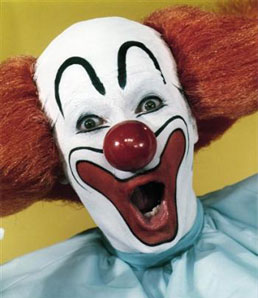

I also have a love for the design of Cat's Don't Dance and a lot of Aladdin. I think it all adds up to the design I ended up with.
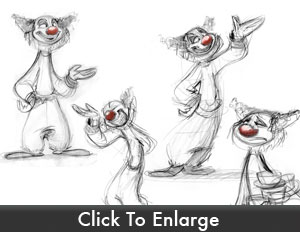
Do you use model sheets and turn-arounds to help you plan your animation?
It's always good to have model sheets and turnarounds, if you use them. I've seen people create model sheets, and turnarounds and then invent a total different character in their key animation.
I did a series of sketches to help with the clown's over all model, but I felt like I didn't have the time to do turn arounds for him, but keeping the volumes consistent is very important for me and I pay close attention to that while I clean up the Key Animation.
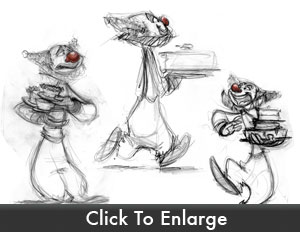
Talk about your animation process.
I have always liked Shamus Culhane's approach to animation. He's all about being really rough and sketchy (and even off model) right up front so you can properly feel the forces and move though the animation in a very viseral way.
Recently, I've been better about taking my rough animation and really nailing down the keys much ealier on in the process. It has truly helped me in the inbetweening process.
So first I do character sketches, then I do thumbnails for the parts of the scene I'm less clear on...
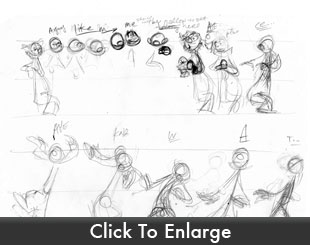
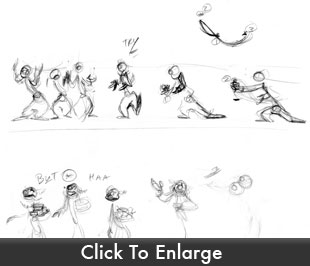
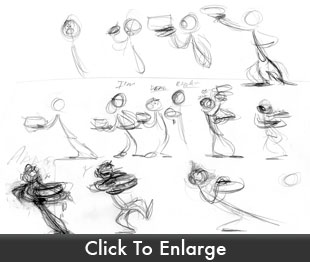
Then I number my xsheet on twos (like the Animator's Survival Kit recommends), then I start scribbling though the first draft on fours and twos and run a test.
Once I like the timing and the overall feel of the test, I go in and really nail down the Keys. And as a good friend of my said, the more accurate you are with this step, the easier it is to get clear arcs and clear spacing in your inbetweens.
After that, it's all about spacing, volumes and arcs.
All of the clown's gestures have super-appealing arcs. Talk a bit about how you think about arcs in your animation.
Arcs are so important for me to get right, I would consider it one of the more important principles in animation to get right very early on in learning the craft. I guess I would consider it mostly a technical animation principle, but where it gets more artistic is the the kind of arcs you choose to keep your animation on. For the Clown animation I chose more overly dramatic and wide arcs for the acting, since he's a very overly dramatic character in parts of the scene.
You could also go the opposite way and have very narrow arcs and less dramatic movements in the acting. You make your arc choices, and then it's a matter of making sure that wrists, noses, shoulders, hands, feet, etc. follow along their natural paths from key to key.
It looks like you had a lot of fun playing with the smear frames at the end of the shot. Can you talk a little bit about how you approached those couple of frames?
Don't put smear frames on twos, like I did. I should have put them on ones. One director I worked a long time with told me to think of it like a camera shutter opening and closing on a really fast action. If the action is fast and the shutter opens and closes slowly it will capture more of blured action than a crystal clear outline of a shape. So if you find the arcs that the shapes are traveling on and smear along those arcs, then I think you're in business!
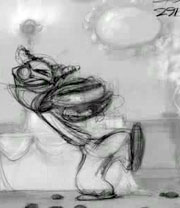
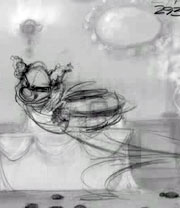
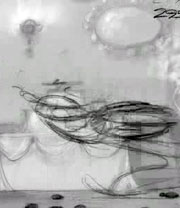
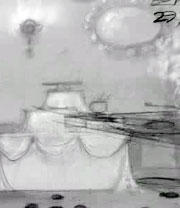
The Maitre D' stands in the same pose the entire scene. Did you ever intend to animate him, or did you construct his pose (and wonderful "snooty" facial expression) to be one that would read as a still character while the clown took center stage?
Well, I think that whatever I planned on doing, I should go back and add a bit of movement to the character. It seemed too distracting for enough people that it took them out of the scene, even if just a little bit. I think I'll have to find a balance between no movement and too much movement.
How have your peers helped you with this scene?
I always try and ask for feedback when I can. A great animator in Chicago, Joe Merideth, helped with parts where the tone of the dialog and the key test weren't working just right. Ryan Gong, a friend and talented animator in SF, helped me adjust some of the posing to make it read better and Jett Atwood, a friend and great storyteller in SF helped me judging the overall idea and feel of the scene. Those are the three people off the top of my head that I know offered very helpful insights.
Did you find yourself struggling with any part of the animation?
Oh, of course! I had to rework almost every section of the piece in one way or another.
My two favorite parts of animation are the very beginning where anything is possible, and the very end when you've made all of your choices and it's one whole piece. Everything in the middle is hard work, at least for me. But the possiblilty and the end result make the entire process totally worth it.
Talk about one or two parts of the eCritique that enhanced or expanded on the ideas you had originally set out to animate.
The eCritique from Jon was excellent. 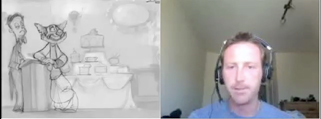
All of his points offered ways to make the acting and the movement clearer. His point about the number of headshakes at the beginning of the dialog is dead on: it really takes away from getting a good read of the expressions on the Clown's face. I also loved the idea of changing the rythym of the last part of the line. I think by going in and making that change will result in a bit more texture in the animation.
I love that he was really looking for more clarity in the intent of the piece. He mentioned that it was a subjective thing, but it's always important to take those kind of insights seriously.
Is there anything you'd like to add about your thought-process or experience in June's competition?
The idea I started with was pretty close to the idea I ended up with. And I think that made the animation easier to do. But that isn't always the case when I work on something. Having the deadline is a great thing about the 11 Second Club. It really makes you choose a path, stick with it and finish it.
This was your first time entering the competition. What advice would you offer to a beginner who wants to enter the competition?
Wow. Well, I can only say what I tried to do with the line I was given. I tried to physically limit my character in some way. I came up with the idea of having him deliver the line while choreographing how he would leave the restaurant with an arm full of desserts. That limitation alone prevented me from falling into the trap of making acting choices similar to animators with the same line to animate.
Trying to think up something that 150 other people wouldn't come up with is hard, but if you can figure that out and animate it well, I bet people will respond to it.
- BJ Crawford
Discuss this interview in the forums
comments powered by Disqus






